3/25/12 – Rough Draft: Thoughts on this rough draft are appreciated! While the thesis will remain (meme transference and diffusion via opinion leaders) I’ll continue cleaning up typos and structure for a bit. If you feel that I need to cover something that I’m not covering or that I need to cover something differently, please let me know.
Last Updated: 7/26/12
NOTE: See also, the quick reference usage timeline
Why and when did transsexual people begin calling themselves transgender? According to some internet memes transsexuals began self-identifying as transgender due to a vast global plot by crossdressers1,2 . According to this conspiracy, transsexuals by the millions were forced by the media3, through a cunning application of crossdresser colonization 4 to start using the term “transgender” sometime in the mid-1990s by a communist.5 The apparent solution to this imagined dilemma is to invent a new term – or string of terms – which means “transgender”6. This meme has survived because, until recently, few seemed to realize that “transgender” was decades older than many seemed to believe. Furthermore, it seems that not many are aware that “transgender” predates the term “transgenderist” – a word whose authorship is almost always erroneously attributed to Virginia Prince.
As we review the historical record, we are presented with a choice. We can choose to believe that “transgender” was shot from the mouth of Virginia Prince straight into the collective hearts of all transsexuals or we can take a more reasoned approach. For instance, since “trans-sexed” originally appeared in print to refer to transgenderists, would it not be absurd for non-transsexual transgender people to spread an internet meme that asserted a global conspiracy on the part of transsexuals to steal this identity away from transgenderists? While it is certainly absurd, this scenario is precisely what has taken place – just in reverse. In this article I will make some reasoned arguments which will attempt to shed some light on why there was a grassroots linguistic tipping point at the end of the 1980s which had trans events/institutions taking on an inclusive semantic in the form of “transgender” – a term which dates back to at least 1965, years before Prince used the trans+gender lexical compound.
Cultural context is important and, from what I’ve observed, is oftentimes missing in the various debates concerning transgender terminology. For instance, I have yet to read where a so-called “Transsexual Separatist” acknowledged that nobody in popular culture referred to Christine Jorgensen as a “transsexual” when she came out. In fact, her famous “Christine Jorgensen Reveals” LP is devoid of the term. We tend to forget that it wasn’t until 1966 that the term entered popular culture with the publication of Harry Benjamin’s seminal work, The Transsexual Phenomenon. Furthermore, we’ve all but forgotten that within just 5 years of “transsexual” becoming the new pop-culture buzz word, Christine Jorgensen was rejecting that identity and instead tried to popularize a new term to describe her experience. Another nuance that is oftentimes lost in these terminology debates is that “transsexual” was, in fact, designed to be an umbrella term which was explicitly inclusive of transsexuals, transgenderists and crossdressers.
.
.
To honestly review the evolution of terms trans people have both used and identified with, we must begin with the opinion leaders of the day and the contextual memes they passed on. A “meme” is an “idea, behavior, style, or usage that spreads from person to person within a culture.” Memes are generally defused within a culture through opinion leaders. These memes can take the form of new jargon (or new interpretations of existing terms) and more. Memes influence the way in which groups intuitively think about what is and is not true, correct or desirable.
So, let’s set the stage:
The Early Opinion Leaders
An opinion leader is an agent who is has access to data and who interprets the meaning of that data for lower-end information consumers. For reasons which will become clear, the significant early modern national opinion leaders that interpreted the trans experience and disseminated those interpretations throughout our culture were Harry Benjamin, Christine Jorgensen and Virginia Prince.
Harry Benjamin – While Jorgensen and Prince didn’t know each other (Prince claims to have met Jorgensen once, but didn’t know her personally7), Benjamin knew them both quite well. He popularized a number of terms such as “transsexual,” “transsexualism” and “transsexualist.” Additionally, he wrote what became the transsexual bible for many years to come: his 1966 book, The Transsexual Phenomenon. While Benjamin8 and Prince both shared the belief that one could not truly change one’s sex, unlike Prince, Benjamin felt that genital reconstructive surgery was generally an appropriate response to what was later referred to as significant “gender dysphoria.” The organization which sets the standards of care for the medical and psychological treatment of transsexualism named themselves after Benjamin: The Harry Benjamin International Gender Dysphoria Association and consequently, for many years those standards also carried his name.
Christine Jorgensen – In her 1958 LP, the interviewer states, “You are without a doubt the world’s most publicized person. There’s the fame, the notoriety, the sensationalism… ” Jorgensen’s story has remained relevant to transsexualism for decades9. No other transsexual reached the type of global notoriety that Jorgensen achieved10. In her book, How Sex Changed: A History of Transsexuality in the United States, author Joanne Meyerowitz writes:
“In 1952 the press discovered Christine Jorgensen and inaugurated a new era of comprehensive, even obsessive, coverage. In the history of sex change in the United States, the reporting on Jorgensen served as both a culminating episode and a starting point.” (2004:49)
In the early newsprint reports, Jorgensen is not referred to as a “transsexual”11. While the term “transsexual” and the name “Christine Jorgensen” later became synonymous, it took 14 years for Jorgensen to be referred to as a “transsexual” in newsprint12. Apparently Jorgensen wasn’t exactly happy with this term being applied to her experiences as Websters Dictionary added “transsex” to their 1971 edition and credited the term’s coinage to Jorgensen. Later in the 1970s, she completely rejected the “transsexual” label and instead began to describe herself as being a transgender person13.
Jorgensen was well acquainted with Benjamin14.
Virginia Prince – In the 1950s, as Jorgensen was educating the public on transsexual issues, Prince began her transgenderist advocacy work15. As such, she became the crossdressing community’s national voice for transgenderist issues16. Prince became one of Benjamin’s patients17 and made quite an impression on Benjamin18. She, like Benjamin, believed that transsexual surgeries did not, in fact, change someone’s authentic sex19. She thought that genital reconstructive surgery was practically always the wrong choice to make20 precisely because she believed that she was dealing with a gender issue and not a sex issue21. Prince used the term “gender” in a way that neither Benjamin nor Jorgensen did.
Prince is credited for coining the term “transgenderist”22 (though Ariadne Kane and Phyllis Frye were using the term before Prince), is given credit for coining the term “transgenderism”23 (though both Kane and Frye were using the term before Prince), is given credit for coining “bigenderal” (though sexologists were using the term before Prince24) and is given erroneous credit for coining “transperson”25 (though Frye and the UK trans community was using the term years before Prince). Prince is currently given credit for coining the term “transgenderal” as a term meaning transgenderist. Erroneous authorship credit for these terms is often cited as proof of Prince’s authorship of the term, “transgender.”
It should be noted that under the Benjamin Scale of Transsexualism, Prince is a Type 4 or 5 transsexual. Not only did Prince want genital reconstructive surgery26, she took hormones prescribed to her by Benjamin, eventually underwent surgery to make her body appear more feminine and she lived full-time as a woman. Prince rejected the term “transsexual” and rejected the way “gender” was used by people like Benjamin and Jorgensen.
Drs. Ekins and King write on page 23 of their 2006 book, The Transgender Phenomenon that Prince’s trans narrative was, “… developed largely in opposition to the two major medical stories available to her: the medicalized ‘transsexual’ story (Harry Benjamin) and the medicalized ‘transvestite’ story (Magnus Hirschfeld).” It should be noted that while the terms were lexically different, both the Benjamin-transsexual and the Hirschfeld-transvestite were, in significant ways, similar in meaning. Both of these medical terms encompassed those who occasionally crossdressed and did not want/need/seek medical intervention as well as those who lived full-time opposite of their sex assigned at birth and who did want/need/seek medical intervention.
.
The Contextual Memes
Transsexual – While it is now known that this term was being used in print as early as 1907, that “transsex” (a term which seems to first show up in 1851) was used to refer to living in a cross-sex gender role as early as 1915, Magnus Hirschfeld is given credit for coining “transsexual” (in German, “seelischer transsexualismus”) in 192327. Later, D. O. Cauldwell used the term “transsexual” to refer to historical transsexuals as well as someone we may have referred to today as being a transsexual28. In 1954 Harry Benjamin used the term “transsexual” and in the same paper coined the terms “transsexualism” ans “transsexualist” to describe people we would certainly call transsexuals today29. Benjamin is responsible for introducing the term into the pop culture lexicon in 1966 with the publication of The Transsexual Phenomenon.
Benjamin used the term “transsexual” to refer to transgenderists and to those who we would today take to be transsexuals. For Benjamin, a transsexual could be someone who lived only part-time in a role opposite to their sex assigned at birth and who did not want to have genital reconstructive surgery (Type 4 Transsexual), someone who perhaps lived full time opposite to their sex assigned at birth but for whom genital reconstructive surgery might or might not be appropriate (Type 5 “True Transsexual”) or the term could have referred to someone who lived full time opposite to their sex assigned at birth and for whom genital reconstructive surgery is always appropriate (Type 6 “True Transsexual”). This view of transsexualism persisted until Paul Walker (the then director of the gender program at the University of Texas Medical Branch in Galveston, Texas) led the effort to medically classify what we currently take to be a transsexual with the publication of the 1979 HBIGDA Standards of Care and its subsequent diffusion into the professional/clinical circles during the early 1980s.
While these various types of Benjamin-transsexuals were clearly explained to the public in 1966 via Benjamin’s The Transsexual Phenomenon, pop-culture’s understanding of “transsexual” only seemed to include the Type 6 transsexual. Both Virginia Prince and Christine Jorgensen didn’t seem to appreciate having this term applied to their experience as both of them seemed to react by taking on other trans terms (Jorgensen, transsex in 1971 and transgender in 1979; Prince, transgenderal in 1969 and transgenderist in 1978).
Gender – By the 1960s, the term “gender change” had become synonymous with the transsexual experience. In 1964, the notion of “gender identity” was born30. In 1965, Johns Hopkins opened their Gender Identity Clinic.31 In 1966, Benjamin wrote in The Transsexual Phenomenon that transsexuals have a “gender problem.”32 By 1967, the American Journal of Psychiatry published the article, Transsexualism and Gender Change.33 On the cover of Christine Jorgensen’s 1968 bio, Benjamin writes:
“Medically, Christine presents an almost classic case of the transsexual phenomenon or, in other words, a striking example of a disturbed gender role orientation.”
That same year, Dr. Harry Gershman brought attention to the idea of “gender identity” in a paper titled, The Evolution of Gender Identity34 and Dr Robert Stoller dedicated a chapter of his book, Sex and Gender to “Gender Identity.”35 This idea was further popularized by John Money and Anke Ehrhardt in 1972.36 By 1974, it was being asserted that transsexuals suffered from “gender dysphoria” – a term which is still used today to describe the transsexual experience.37 By 1979, the standards of care for transsexualism was named the Harry Benjamin International Gender Dysphoria Association Standards of Care and by 1980 “Gender Identity Disorder” (GID) was entered into the DSM-III to cover transsexualism as a psychological disorder.
Prince vehemently argued for many years that gender was akin to a social costume; according to Prince, gender was a state of being within a culture and sexual identity was a state of being conferred upon one’s body38. In Prince’s view, sexual identity was only ever physiological and gender was only ever psycho-social39; for her gender meant cultural sexual roles which involved consumes and behaviors40. She often chided others for not knowing the difference between sex and her definition of gender41. Prince’s notion of gender was at odds with the way in which Jorgensen and Benjamin (and most other sex researchers) used the term. For Jorgensen and Benjamin (and most other sex researchers) gender was more than just cultural sex stereotypes to be taken on 42, it was, as Dr. Stoller wrote in 1964…
Gender identity is the sense of knowing to which sex one belongs, that is, the awareness ‘I am a male’ or ‘I am a female’. This term gender identity’ will be used in this paper rather than various other terms which have been employed in this regard, such as the term ‘sexual identity’. ‘Sexual identity’ is ambiguous, since it may refer to one’s sexual activities or fantasies, etc. The advantage of the phrase ‘gender identity’ lies in the fact that it clearly refers to one’s self-image as regard to belonging to a specific sex. Thus, of a patient who says: ‘I am not a very masculine man’, it is possible to say that his gender identity is male although he recognizes his lack of so-called masculinity. – International Journal of Psychoanalysis, 1964, v 45, pages 220 – 226
Jorgensen echos Dr. Stoller’s concern over the use of “sex” in terms associated with her experience saying in 1985, “I am a transgender because gender refers to who you are as a human.” In 1982, a news article has this to say:
Ms. Jorgensen, now 56, said in a speech to Fresno State University students Monday that she describes people who have had such operations’ “transgender” rather than transsexual. “Sexuality is who you sleep with, but gender is who you are,” she explained.
For most, gender and sex seems to have existed in a non-duilistic/holistic state so that gender did not exist within a mind which was somehow separate from the body. As Drs. Elkins and King wrote:
If we combine these various insights of Garfinkel, Schutz and Giddens, we reach a position where it becomes evident that much of the ‘science’ of sex, sexuality and gender is rooted in what ethnomethodologists call the ‘natural attitude’: most fundamental and pervasively, the binary gender divide viewed unproblematically. Thus, when scientists became confronted with ‘exceptions’ that don’t ‘fit’ the binary, they typically seek to ‘explain’ the exceptional rather than problematizes the ‘natural attitude’.
Taking the insights of ethnomethodology seriously, it is no longer possible to argue that sex is nature and gender is socio-cultural. Both become seen as socio-cultural. The binary itself is a social construction. And if this is the case, the political and ethical nature of science in matters of sex, sexuality and hinder becomes more apparent. ‘Science’ has consequences and the way is open for transgendered people categorized by ‘science’, to argue for alternative conceptualizations in the name of science, as well as in the name of ethics and politics. – The Transgender Phenomenon, 2006, pp 26-27
Transgender – The earliest known usage of the trans+gender lexical compound was a 1965 psychological usage of “transgenderism” to refer to transsexualism. At the time, transsexualism was seen as being an extreme subset of transvestism (which was inline with the views popularized by Magnus Hirschfeld). This 1965 usage asserted that “transsexualism” as a term was incorrect because “sexuality” (the sexual drive) isn’t the reason behind the drive to transition; the book asserts that gender was the driving force behind the need to transition and therefore “transgenderism” would be a more correct term. By 1970, the term “transgendered” showed up in the TV Guide referencing a supposed transsexual movie character43. By the early 1970s, the term showed up in books referencing transsexuals44 and was used as an umbrella term inclusive of all types of non-cisgender experience and expression in print and at a 1974 trans conference45. By the mid-1970s, the term began showing up in pop culture (eg, referencing the rock star Alice Cooper46, used as an adjective47, etc). By the mid-1970s, regional trans leaders were rejecting “transsexual” by using variations of “transgender.”48 By the close of the 1970s, Jorgensen publicly disavowed “transsexual” in favor of “transgender.”49 Throughout the 1980s, the term is used to refer to transsexuals.50 However, by 1983, I found that the term “transgenderism” seems to have been shortened to “transgender”51 even though that same year the transsexual classic, The Uninvited Dilemma explicitly supports the use of transgender over transsexual52. By 1984, the term is again being used as an umbrella term which was inclusive of both transsexuals and crossdressers.53 By the mid and late-1980s, the term became interchangeable in common usage so that a transsexual and/or crossdresser might be transgender.54 This continued as a strictly grassroots trend until trans events, organizations and publications began to embrace “transgender” in the late 1980s and early1990s. When In Search of Eve was published in 1987, the book used “transgender” to describe the transsexual experience55. In 1986, the Transgender Archives was founded and “transgender” was used as an umbrella term56. When the first international trans event took place in the early 1990s, the event used “transgender” in its name as an umbrella term and event literature provided a clear definition of what the term meant and made it clear that transgender and transgenderist were not the same thing.
Currently, the creator of this term is unknown.
Transgenderist – The earliest know usage of this term occurs in an early 1975 trans newspaper and while Ariadne Kane’s and Phyllis Frye’s usage of this term was years before Prince’s usage, credit is still given to Prince for coining the term in 1978. Phyllis Frye was using the term in 1975 and credits a newspaper published by the national director of the United Transvestite and Transexual Society for introducing her to the term. It should be noted that when Prince was 81 years old, she said that she the thought she might have said the term “transgenderist” at a conference in 1974 or 7557; however, around that same time, she also told Leslie Feinberg that she coined the term “transgenderist” in the late 1980s58. In all of Prince’s copious writings – right up until 1978 – Prince did not use the term “transgenderist” once; not even when she attempted to explicitly classify the various types of trans people in 197759. What we do known is that the earliest usage of “transgenderist” found in print is in 1975.
A June 2, 1979 article of the Radio Times states “It is estimated that about one person in 2,000 is a transgenderist – someone who feels an overwhelming need either to dress in the clothes of the opposite gender, or . . . to ‘change sex’ completely.” Days later on June 6th, Claire Raynor, on the BBC 4 radio show Crossing Over explained the term this way: “Transgenderists – the rather clumsy label that has been devised to cover both transvestites and transsexuals.”60 The 1979 on-air usage was used in the same way “transgender” had been used in 1974: as an umbrella term.
The term saw a steady increased usage throughout the 1980s, but saw an enormous spike in usage between 1991 and 199661.
Currently, the creator of this term is unknown.
Transgenderal – Thus far, Prince’s use of this term is the earliest yet discovered in print. If she did indeed coin this term, she seems to have repourpused Benjamin’s popularized term (transsexual) and in 1969 and wrote “transgenderal” (trans+genderal – “genderal” was a term Prince commonly used62) once in her 1969 booklet63. She never used the terms again64. After the 1969 usage, I’ve not yet found the term used again in print until 1980 where it’s used as a synonym for the German word, übergeschlechtliche65.
Transgenderism – Prince claims to have coined “transgenderism” to specifically refer to the “transgenderist” experience in 1978. However, Phyllis Frye was differentiating between “transgenderism” and “transvestism” in 1975 and Ariadne Kane was using the term in 1976. As noted above, the term seems to have become conflated with “transgender” by 198366. By the early to mid 1980s, the term was closely associated with transgenderists, however, by 1986 the term was in use only half as much as it was in 1980. Usage increased as by 1990 and became synonymous with the modern usage of transgender.67
Currently, the creator of this term is unknown.
“Trans People” – Currently, the earliest use of this term was during a trans conference held in 1974. Additionally, Phyllis Frye began to use “trans-person” as an umbrella term before Virginia Prince. Nonetheless, Prince is given credit for coining the term in the 1978.
Currently, the actual author of this term is unknown.
“Gender Dysphoria” – Dr. Norman Fisk popularized this concept in 197468. As “Gender Dysphoria” began to enter into the pop consciousness of the world via books, speeches and newsprint, it became synonymous with “transsexual.” However, the term was actually meant as an umbrella term for all who were dealing with gender issues:
“The concept of gender dysphoria syndrome grew out of clinical necessity very much in an organic, naturalistic fashion… I readily agree that classical transsexualism as best described by Dr. Benjamin represents the most extreme form of gender dysphoria… [After undergoing treatment through Fisk’s Gender Clinic] There exists additional evidence to further validate the point that for all groups (except for the gender dysphoria syndrome sub-diagnosis transvestitism) there was statistically significant improvement in social adjustment, psychologic adjustment, economic achievement and, for all groups, including transvestites, a highly significant improvement in sexual adjustment.” – Norman M. Fisk, 1974
Prince claimed that this umbrella usage was incorrect since, in her view, gender only amounted to a cultural sex costume and therefore could not be applied to the transsexual experience69. By the end of the 1970s, the body that’s responsible for setting the standards of care for the medical and psychological treatment of transsexualism named itself the Harry Benjamin International Gender Dysphoria Association.
Karl Heinrich Ulrichs spoke of a “feminine soul enclosed in a male body” (Die Geschlechtsnatur des mannliebenden Urnings, eine naturwissenschaftliche Darstellung: körperlich-seelischer Hermaphroditismus. Anima Muliebris Virili corpore Inclusa) in 1868. Ulrich spoke of a mental (seelischer) intersex condition (Hermaphroditismus) as being part of one’s essential personhood (anima). However, this and later use of the “wrong body narrative” was generally used to describe a stereotypical female sexual drive within the body of a male.70 Magnus Hirschfeld echos Ulrich’s “körperlich-seelischer Hermaphroditismus. Anima Muliebris Virili corpore Inclusa” with his 1923 term, “seelischer transsexualismus.” It isn’t until Jorgensen popularized the experience of having one’s essential personhood trapped in an oppositely sexed body that gender was popularized as being the subjective experience of one’s sex within the context of a culture.71 “I was a woman masquerading in a seemingly male body,” said Jorgensen to her early endocrinologist, Dr. Christian Hamburger. Only after Jorgensen popularized this dysphoric experience of gender as a reaction to one’s physical sex that Dr. Stoller writes of “gender identity” in a way that recognized Jorgensen’s subjective experience. The notion of an identity based upon the subjective experience of one’s sex as understood by one’s essential personhood instead of an identity based upon the experience of possessing a sex within a culture “irked” Prince in the same way it tends to irk modern critics of gender identity such as J. Michael Bailey and Ray Blanchard.
Umbrella Semantics: Umbrella terms that were used to describe the non-cisgender experience have existed for more than a century.
- Transgesticismus – This 1920 term was originally an Karl Ulrichs term (transgestismus), but was modified by Hirshfield to refer to people who behaved in a cross-sexed manner.72
- Hermaphroditismus (hermaphrodite) – Under Hirshfield’s intersex types, all trans people were classified as being some type of intersex person.73 This classification persisted well into the late 1950; on her 1958 LP, Jorgensen – while making it clear that she was not a true “hermaphrodite” – nevertheless discussed her experiences as an expression of sex that was caught between two bianary states of sex.
- Zwischenstufen and Geschlechtsüebergäenge – According to the 1914 Lexicon of Sexology, these two terms were used to describe anyone who was not stereotypically male or female.74
- Transvestitismus (transvestite) – Originally coined in 1652, to reference crossdressing women75, Hirshfield viewed this as a catch-all term for anyone with a “mixture of mental gender differences” (Mischung seelischer Geschlechtsunterschiede, 1918:89). In a 1931 report recounting the genital reconstruction surgeries by Berlin doctor Ludwig Levy-Lenz, the transsexuals in the report were referred to as transvestites. Transvestite was used as the umbrella term of its day and basically meant what transgender means today.
- Transsexual – When Benjamin popularized this term, he meant it as a taxonomy for all part/full-time cross-sex living people whether or not they took hormones and/or undertook any surgical intervention.
- Trans – By the mid-1970s, this term was used as an umbrella term to describe all crossdressers and/or transsexuals.
- Transgender – First used as an umbrella term in print and during a trans conference in1974, a decade later the term was being commonly used as an umbrella term.
.
Meme Transmission
The diffusion of memes into a culture oftentimes occurs due to the copying of an observed behavior of another individual, but memes may transmit from one individual to another through a copy recorded in an inanimate source, such as a books, newspapers, recordings, movies, etc..
Culture of Collaboration – During the 1970s, numerous collaborative efforts (both on a national and local scale) were undertaken by various types of trans people who chose to group themselves together and work in support each other76. Transsexuals openly supported transvestites77 and transvestites openly supported transsexuals78. Letters from transsexuals were published in “TV/TS” publications urging for more collaboration79. National organizations were organized to be explicitly inclusive of all80. By the 1970s, trans leaders began using explicitly inclusive terms like “trans person” in their advocacy work81. By the 1980s, trans communication avenues (eg. magazines82, early internet83 and groups84) were actively engaged in the diffusion of norms which held that all trans people were part of one community. By 1992, the International Transgender Law Conference (ICLEPT) was held and defined “transgender’ in the following way:
Transgendered persons include transsexuals, transgenderists, and other crossdressers of both sexes, transitioning in either direction (male to female or female to male), of any sexual orientation, and of all races, creeds, religions, ages and degrees of physical impediment. – Pamphlet for the 1992 ICLEPT
.
.
Conclusions
The evidence is that “transgender” existed years before “transgenderist” did and there exists no evidence to support the idea that Prince’s one obscure use (and then immediate abandonment) of “transgenderal” is where all trans terms come from, especially in light of the fact that “transgendered” appeared in print years before Prince used a trans+gender lexical compound. No evidence exists to support the notion that Prince coined “transgenderist,” “transgenderism,” “trans,” “trans people” or “transgender.” The evidence shows that throughout the early use of “transgender,” the term is used to exclusively reference the transsexual experience with the exception of two 1974 usages when it was used as an umbrella term. No usage of “transgender” from the early 70s has yet been found which refers to crossdressers alone. I think it’s clear that the use of “gender” to describe the transsexual’s dilemma is largely responsible for the early 1970s use of “transgender” when referring to transsexual issues. With the exception of “transgenderal,” I think that it’s most appropriate to cease claiming that we know who coined any of the trans terms I’ve reviewed in this article.
Both Prince and Jorgensen were TS separatists in their own right; neither of them chose to identify with the term (transsexual) Benjamin had used to describe their experience. Both Prince and Jorgensen were transsexuals under the Benjamin standard and both of them rejected that identity soon after it was popularized. Around 1970, both Prince and Jorgensen were playing with new terminology to describe their experience. By the late 1970s, both were using and promoting terms neither of them had created to describe their experience. Jorgensen began using “transgender” – a term which had been around for years and seems to have meant Type 5 or 6 transsexual on the Benjamin scale. Prince began using “transgenderist” – another term which had been around for years and seems to have meant Type 4 or 5 transsexual on the Benjamin scale. When the evidence is objectively reviewed, the story it tells is that different types of Benjamin Scale Transsexuals were searching for, finding and then promoting terms they felt better represented their experience.
It should be noted that the rejection of Benjamin’s terminology occurred within the context of a trans community that clearly valued unity while rejecting uniformity. It’s clear that the various parts of the trans population regularly worked together. The trans community had been using “trans” as a simple umbrella term since the mid 1970s. Whether it called itself the “gender community,” the “TV/TS community,” the “paraculture” or the “transgender community” the intent has always been the same: the recognition of the various types of trans groups who share some common issues and who could work together for common cause. Examples of efforts to cultivate unity (not uniformity) abound throughout the 70s, 80s and 90s from practically all aspects of the trans community.
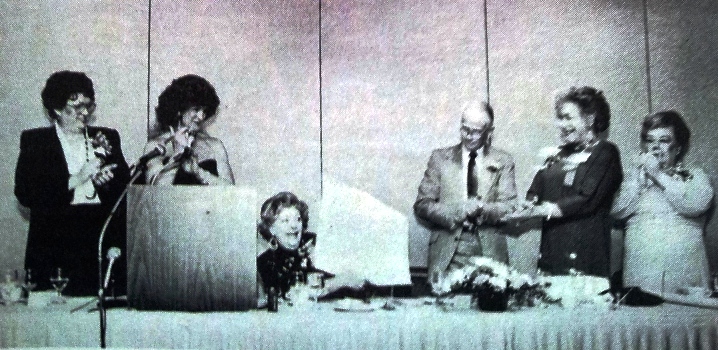
While I can find two 1974 umbrella usages of “transgender” and two British umbrella usages of “transgenderist” in 1979, the delineation between the two terms tended to be clear throughout most of the 1970s and very early 1980s until the non-trans community began to use the term more frequently as an adjective outside of the context of the trans community. Throughout the 1980s, popular transsexual books continued to use “transgender” in the same way Jorgensen promoted it. At the same time (throughout the 1980s) there are numerous examples in which non-trans writers use “transgender” as an adjective when discussing non-trans topics. By 1983, I seem to have found “transgenderism” shortened to transgender in a trans community magazine; however this was by no means a total lexiconic shift so that transgender only ever meant transgenderist in some absolute sense from that moment forward. It is from this time within in trans linguistic history is, I believe, where some got the mistaken impression that transgender came from transgenderist.
Most of what has to be done has to be done by the transgendered person with help from others in the transgender community. First, such a person has to stop looking for a scapegoat – whether that scapegoat is a biological structure or a societal structure. If her/his biology really causes the ‘problem’, short of reassignment surgery, there is not much that can be done. If society is the issue, then choices are few and most will opt to stay in the society they know, even if it rejects them. As a result, one has to ‘pick themselves up by their bootstraps’ and see themselves as worthy, responsible and lovable human beings. This can not be accomplished alone and that is where the community comes in. – TV/TS Tapestry, 1984
With transgender showing up as an adjective, a noun meaning transsexual and a shorted form of transgenderism, I don’t find it surprising that by 1984 I find a trans publication discussing the importance of a “transgender community” wherein “transgender” is used in it’s modern context. Within a few years, “transgender” had – through grassroots usage – become a semantic umbrella designation and an adjective.
This grassroots usage continued throughout the 1980s even though “transgenderist” was clearly still in wide use. By the late 80s and early 90s, it is clear that the users of the term understood that a transgenderist is just one of the many types of trans folk who were transgender.
The continuous use of “transgender” to refer to the transsexual experience from 1970 through 2012 does not support the notion that transsexuals didn’t use the term until the mid 1990s. The obscurity and immediate abandonment of transgenderal does not support the notion that all transgender terms were given birth from this term. Additionally, I am not confidant, given the numerous other erroneous attributions of authorship given to Prince, that earlier non-Prince usages of “transgenderal” won’t be discovered. The fact that transgender, trans, transpeople, transgenderist and transgenderism were all in use prior to Prince’s use does not support the notion that Prince invented these terms. The fact that transgender was in use prior to transgenderist and transgenderism and was used in reference to transsexuals or as an umbrella term does not support the notion that transgender came from transgenderist or transgenderism. The fact that we currently do not know who invented transgender, trans, transpeople, transgenderist or transgenderism does not support the practice of assigning authorship to anyone; the correct thing for researchers to do is to honestly state that we do not currently know who coined these terms. The grassroots drive toward a unified (but not uniform) community is easily tracked from 1970 to 2012 and does not support the notion that no community existed prior to the mid-1990s or that this community somehow popped into existence due to the mid-1990s edicts of a handful of trans leadership.
On page X of Leslie Feinberg’s 1996 book, Transgender Warriors: Making History from Joan of Arc to Dennis Rodman, Feinberg states, “Today the word transgender has at least two colloquial meanings. It has been used as an umbrella term to include everyone who challenges the boundaries of sex and gender. It is also used to draw a distinction between those who reassign the sex they were labeled at birth, and those of us whose gender expression is considered inappropriate for our sex.” What reasoned argument can be made to assert that Feinberg’s 1996 understanding of “transgender” was in any substantive way different than the demonstrated usage of the term throughout the 1970s? Thus, laying at the heart of my thesis is a keen awareness that there is, in fact, no objective difference to be found.
In short, there’s no evidence to support the memes I discussed at the beginning of this article. Ironically, one need only look to those who push these memes to discover who is actually acting to strip the transsexual community of its history and language. The term “transgender” has been a part of transsexual culture, history and identity for almost as long as the term “transsexual” has even appearing in print to describe transsexualism a year prior to the publication of Benjamin’s The Transsexual Phenomena. Practically as soon as as the term “transsexual” entered the pop lexicon in the mid/late-1960s, within just a few years we have the transsexual experience being referred to as “transgendered” and then we have the world’s leading transsexual opinion leader publicly rejecting “transsexual” in favor of other terms: transsex (1971) and transgender (1979).
Those who would shut the door on this transsexual history are asking us to live in a fictitious victim world that pits transsexuals against other trans folk in a battle for identity. I, as a post-op transsexual woman, am proud of the transsexual community’s actual history. I’m glad that I’m not a victim of some global conspiracy of colonization. I’m glad that my community has a long, long history of working hand and hand with other types of trans populations as equal stakeholders in a shared experience. It is a fact that this transsexual-initiated approach to progress has continued to pay off. Trans protections are proliferating and the zeitgeist has become less and less tolerant of anti-trans sentiment.
Thus I, like Christine Jorgensen and many transsexuals before me, am a proud transgender women.
NOTES
This is a personal blog version of the rather dry review of data that will be posted to my trans research blog (research.cristanwilliams.com) later this month. Please feel free to respond to this post with your insights and/or typos you’ve caught.
1.) “The coiner of the term transgender was Virginia Prince, a heterosexual crossdresser who held those of us who had sex reassignment surgery in contempt. Virginia was particularly vicious in her opinion regarding WBTs who were lesbian after sex reassignment surgery. She called us freaks and mistakes.” – TS-SI.org,[link], 5/7/2007
2.) “As many people are aware, Virginia Prince, a male crossdresser and a staunch promoter of heterosexual transvestism since the late 1950s, invented the term “transgender” in the 1990s to distinguish male crossdressers from men and women born with HBS. ” – TS-SI.org,[link], 12/30/2007
3.) “After that conversation, somebody posted this to our online forum: As a transsexual-identified woman, I find the use of the words transgender, transgenderism, gender nonconforming and gender variance highly offensive when applied to me. These are LGBT community buzzwords that should only be applied to their community – not to transsexuals that live outside of it, or that aren’t trying to break gender norms. The LGBT community efforts to push this word to include all transsexuals is shameful. She blogs under the name Transsexual People Aren’t Transgendered.” NPR,[link], 4/1/2011
4.) “… Virginia Prince, a male crossdresser… Calling himself “transgender” rather than a “crossdresser” or a “transvestite” was an attempt to remove himself and other similar “transgenders” from the negative cultural baggage and the concurrent approbation that is linked to male crossdressing.” – TS-SI.org,[link], 12/30/2007
5.) “Feinberg, a Marxist… [asserted that] True transgender liberation requires the overthrow of capitalism, just as any truly revolutionary social change must address the question of transgender liberation. In simple non-dialectic terms, Feinberg believes that capitalism and transgenderism are mutually exclusive. You must be a socialist, or a communist, or maybe even an anarchist if you are truly transgendered.” – TS-SI.org,[link], 12/30/2007
6.) “In Australian human rights circles already there is a new term to replace Transgender as the community/issues umbrella term so as to be more inclusive of diversity and be more accurate. The new term is S&GD or Sex and Gender Diversity… That way it can include Intersex people, Transsexuals of strong binary-gender identity who feel that transgender does not describe them as their gender is quite fixed not ‘trans’ at all as well as less binary transsexuals, bi-gender, genderqueer, crossdressers etc. So we may all band together for the sake of each others human rights while also recognising we are not all the same but varied and diverse. This can also be extended to SS&GD Sexuality Sex and Gender Diversity. Which is much more rational and fair and inclusive and less cumbersome than GLBTTIQQ etc. ” – crossdresserclub.com,[link], 5/23/2010
7.) “At one point, she got a chance to meet Christine and her mother as she was performing in L.A. Jorgensen was a curiosity, but Virginia had no impression of her otherwise.” – (2009). Interview with Prince, Association for Transsexual Support Newsletter, V Foster
8.)“[SRS] does not change you into a woman. Your inborn (genetic) sex will remain male. If the surgeion castrates you as part of the operation, you would be, technically and from a glandular point of view, neither male nor female. You would be a ‘neuter.’” – Benjamin, H. (1963:293). Sexology. New York: Sexology. [LINK]
9.)“Even as transgender narratives multiply, Jorgensen’s story still compels.” – Creating Christine. (2001, March 27). The Advocate, p.66.
“Christine will be missed by many of us and remembered by us all for many reasons. One is a stance she once took on civil rights: “If a law can be created in Dade County Florida against homosexuals, then where will it stop?… You’re opening up the floodgate to discrimination against everybody.” Now that everyone has been caught off guard by new legislation that legalizes housing discrimination against the transgendered, Christine’s statement looks prophetic. Mostly, though, she’ll be remembered as a personality… Our celebrity. National TV and TS organizations accorded her superstar rank, with the status and prestige that went with it. She was constantly in demand at one lavish awards banquet after another, and surrounded by fans and autograph seekers.” – (1989). TV-TS Tapestry, pp.71, Issue 54. [Link]
10.)“On December 1, 1952, the Daily News ran a story headlined “EX-GI BECOMES BLONDE BOMBSHELL,” turning Christine Jorgensen (1927-1989) into an instant celebrity and the most famous transsexual figure of the 20th Century.” – The Kinsey Institute website [link]
11, 12.)Using Google archive search, it took until 1973 to find Jorgensen referred to as a transsexual in newsprint when reviewing Google’s top archived news hits for “Christine Jorgensen.” (searching between the years 1951 and 1973) The Houston Transgender Archive is in possession of a 1966 newsprint article which refers to Jorgensen as a transsexual. – research.cristanwilliams.com, [Link]
13.) “If you understand trans-genders,” she says, (the word she prefers to transsexuals), “then you understand that gender doesn’t have to do with bed partners, it has to do with identity.” – (1979). Newsday article reprinted in the Winnipeg Free Press, [link]
“Ms. Jorgensen, now 56, said in a speech to Fresno State University students Monday that she describes people who have had such operations’ “transgender” rather than transsexual. “Sexuality is who you sleep with, but gender is who you are,” she explained.” – (1982). Associated Press Article, [link]
“The word transsexual irks Jorgensen because the word sex, she believes, is only relivant to what one does in bed. I am a transgender because gender refers to who you are as a human.” – Williams, C. (2011). Christine Jorgensen: Transgender Woman. Retrieved March 25, 2012 from http://research.cristanwilliams.com/2011/08/21/christine-jorgensen-transgender-woman/
14.) “Harry Benjamin, who in 1953 became Christine Jorgensen’s endocrinologist in the united States…” – (2010:219). Please Select Your Gender: From the Invention of Hysteria to the Democratization of Transgenderism, P. Gherovici
“In the early 1950s Benjamin wrote to Doris: “The papers here are full of the Jorgensen case, the boy who went to Denmark to be operated on and is now coming back as a girl. I’ll probably see the party when she gets home” (personal communication, Dec. 3, 1952). Immediately, mutual friends arranged for Christine and Benjamin to meet, and months later in April 1953, the 27-year-old “GI turned Blonde Beauty” (Jorgensen, 1967, pp. 110-111; New York Daily News, December 1952) became Benjamin’s seventh patient with gender dysphoria. Although Harry never made the original diagnosis of her transsexualism, his meeting with “the Jorgensen girl” was the onset of a relationship that lasted the rest of his life. Benjamin monitored Christine’s hormones and discussed with her the multiple problems facing transsexual people.” – (1987). Harry Benjamin’s first ten cases (1938-1953): A Clinical Historical Note, LC Schaefer & CC Wheeler
15.) (1957:80-85). Homosexuality, Transvestism and Transsexualism, AJ of Psychotherapy, v11.
16.) “In 1961, shortly after founding Transvestia, Prince got together some of its subscribers who began to meet in the Los Angeles area. Known initially as the Hose and Heels club, in 1962 this began to evolve into a national organisation called the Foundation for Full Personality Expression (FPE or Phi Pi Epsilon) with a magazine for members called Femme Mirror (Prince, 1997b: 352).” – (2005).Virginia Prince: Transgender Pioneer, R Ekins & D King
17.) “Prince also began in the 1950s, as we have seen, to enter into a dialogue with leading members of the medical profession in this area, such as Benjamin.” – (2005:5-15). Virginia Prince: Pioneer of Transgendering (ed: Richard Ekins. and Dave King) The Haworth Medical Press, an imprint of The Haworth Press, Inc.
“How Prince met Benjamin is unclear but Benjamin had a summer practice in San Fran-cisco (Person, 1999: 359) and in The Transvestite and His Wife (Prince 1967: 6) Prince ac¬knowledges the help Benjamin was to her “personally in my parental and marital problems,” so presumably their first encounters were of a professional nature.” – (2005).Virginia Prince: Transgender Pioneer, R Ekins & D King
“Virginia related she was also good friends with Dr. Harry Benjamin, who in fact gave her her first prescription for estrogen.” – (2009). Interview with Prince, Association for Transsexual Support Newsletter, V Foster
18.) Benjamin (1966:36), in a discussion of Prince’s work, refers to her as “teacher, men-tor and spokesman for the transvestite ‘soror-ity.” Riddell (1972) less flatteringly called her “the arch transvestite of the ghetto.” – (2005).Virginia Prince: Transgender Pioneer, R Ekins & D King
19.) “Moreover, a male could not, possibly achieve a “complete female identity”. Even TSs don’t completely accomplish that because they are not complete females, did not grow up and become socialized as females. There are feminine names and there are names of females, but there are no female names. Male and female imply anatomical differences. Clothing, names and behavior do not have any sex organs and therefore cannot properly be called female.” – Williams, C. (2012). Letter to Tere Fredrickson, 1991. Retrieved March 25, 2012 from http://research.cristanwilliams.com/2012/03/10/1991-letter-from-virginia-prince/
“Someone once referred to Virginia as a “pre-op.” – a term she said had no meaning to her. To back up her view, she quipped, “we’re all pre-dead! What does that mean?” In her view, if you’re not a transsexual, you’re a transgenderist – a term she coined and uses to identify herself. In fact, she considers sexual reassignment surgery a mistake for anyone, and doesn’t really understand one’s identification with transsexuality.” – (2009). Interview with Prince, Association for Transsexual Support Newsletter, V Foster
20.) “However, Prince not only described her own solution, she spoke out forcefully against sex reassignment surgery and must have upset quite a few people by arguing that it is not appropriate for about 90% of those requesting it, writing of “so-called” or “pseudo” transsexuals. “Sex reassignment surgery is a communicable disease,” she has asserted (Prince, 1978b: 271), arguing that susceptible transvestites are seduced by the publicity given to the topic into thinking it is the solution to their problems. On the topic of sex reassignment, the style which underlies all of Prince’s writings comes to the surface: she does not raise points for the reader to consider, rather she tells you what is what; if you disagree, it is because you don’t understand, not because she is wrong; there is nothing tentative about her writing.”– (2005).Virginia Prince: Transgender Pioneer, R Ekins & D King
21.) “I, at least, know the difference between sex and gender and have simply elected to change the latter and not the former.” – Change of Sex or Gender, Transvestia, V Prince; 10(60): 53
22.) “Another term I use throughout the book is transgenderist, coined by pioneer gender researcher and transgenderist Virginia Prince” – (1994:2) Transgender Nation, Gordene Olga MacKenzie
23.) “Virginia Prince[1] coined the word transgenderism which is a blanket term for both transsexualism and transvestism and authored books like Understanding cross dressing and seventy years in the trenches of the Gender wars.”Indian J Psychiatry. 2009 Jan-Mar; 51(1): 73–75 [link]
“She also claims to have “coined the words ‘transgenderism’ and ‘transgenderist’ as nouns describing people like myself who have breasts and live full time as a woman but who have no intention of having genital surgery” (Prince, 1997a: 469).” – (2005).Virginia Prince: Transgender Pioneer, R Ekins & D King
24.) “Both heterosexual men and homosexual women; I would define this relationship as bigenderal, and DSM-III defines it as bisexual.” – (1989:59). Sexology: an independent field : proceedings of the IXth World Congress of Sexology
25.) “The `Transcendents’ or ‘Trans’ People” (1978a), the final article by Prince included in this volume, is significant for a number of reasons. It illustrates, once again, just how far ahead of her time Prince was. Here, Prince uses the term “trans” people to include “people generally called ‘transvestites, transgenderists and transexuals'” (Prince 1978a: 86), anticipating by some twenty years a current popular usage. Moreover, her argument that -trans” people “transcend” the gender “barrier” (p. 86) edges towards some of the “gender outlaw” positions of the 1990s.” – (2005).Virginia Prince: Transgender Pioneer, R Ekins & D King
“[In 1974] some of the terminology used at the conference would take some twenty years to become widespread. As far as we are aware, the first use of the term trans.people (sic) was when Julia Tonner referred to “the two worlds of the trans.people” (ie transsexuals and transvestites). In addition, there was also talk of transsexuals seeking ‘gender alignment’ and of ‘trans-gender’ also used as an umbrella term.” – (2007) Gendys Journal, D King & R Elkins
26.) “… she admits to being attracted by the idea of sex reassignment for herself at the time of the publicity given to the case of Chris¬tine Jorgensen (Prince, 1978b: 271)…” – (2005).Virginia Prince: Transgender Pioneer, R Ekins & D King
“… immediately after hearing about Christine Jorgensen. ‘When she hit the newspapers,’ Virginia related, ‘if I’d had $5,000, I’d have been on the next boat to Denmark!’ ” – (2009). Interview with Prince, Association for Transsexual Support Newsletter, V Foster
27.) (1923). Die intersexuelle Konstitution, Jarhbuch fuer sexuelle Zwischenstufen, M Hirschfeld
28.) “That there are better integrated transexuals we are well aware. There are case histories of outstanding social, civic and other leaders who were transexuals. In Arkansas a comparatively few years ago a Dr. Brown lived and practiced until in the 60′s and was regarded as a male and a highly competent physician. She lived with a sister. In her final illness physicians who treated her discovered her true sex.” – Ekins, R. & King, D. (2001). Psychopathia transexualis. In International Journal of Transgenderism,5(2). Retrieved March 25, 2012 from http://www.iiav.nl/ezines/web/ijt/97-03/numbers/symposion/cauldwell_02.htm
29.) “Similarly the term “transsexualism” answers a practical purpose and is appropriate in our present state of knowledge. If future research should show that male sex organs are compatible with (genetic) female sex or female sex organs with (genetic) male sex the term would be wrong because the male “transsexualist” is actually female and merely requires a transformation of genitals.” – Transsexualism and transvestism as psychosomatic and somatopsychic syndromes by Harry Benjamin, American Journal of Psychotherapy, vol 8, 1954 p 219-230
30.) (1964:220 – 226) International Journal of Psychoanalysis, 1964, v 45
31.) “The model for this collaboration began at The Johns Hopkins Hospital, where the Gender Identity Clinic began its operation in 1965 (Edgerton, 1983; Pauly, 1983).” – Arch Sex Behav. 1986 Aug;15(4):315-29.
32.) (1966:37) The Transsexual Phenomenon, H Benjamin
33.) Transsexualism and Gender Change, Donald W. Hastings, The American Journal of Psychiatry. 1967 December ; 6(124):864-864
34.) The Evolution of Gender Identity, Harry Gershman, M.D. (1968). American Journal of Psychoanalysis, 28:80-90
35.) (1968). Sex and Gender: On the Development of Masculinity and Femininity, R Stoller
36.) Man and woman, boy and girl: Differentiation and dimorphism of gender identity from conception to maturity.Money, John; Ehrhardt, Anke A. Oxford, England: Johns Hopkins U. Press. (1972). xiv 311 pp.
37.) Dr N M Fisk, Gender dysphoria syndrome – The conceptualization that liberalizes indications for total gender reorientation and implies a broadly based multi-dimensional rehabilitative regimen. West J Med. 1974 May; 120(5): 386–391.
38.) “You all have histories where people report that, “Ever since I was this high, I used to pray to God that I would wake up in the morning a girl.” I asked these people, “So you made this prayer. Suppose you woke up the next morning and your penis and testicles were gone and you had a vagina. You had the same clothing, took the same books to school, went to the same class, played the same baseball games with the boys and did everything that you did the day before. Would you think that God had answered your prayer?” They would say, “Well, no I didn’t want that. I wanted to be a girl.” The concept of girlness and femaleness are blurred together. What they are seeking is gender change, but not a sexual change.” – (2005:5-15). Virginia Prince: Pioneer of Transgendering (ed: Richard Ekins. and Dave King) The Haworth Medical Press, an imprint of The Haworth Press, Inc.
[It should be noted that the above dualistic thought experiment is a false dichotomy. The 3rd choice presented by Jorgensen and Benjamin – a choice we see excised throughout Prince’s philosophy – is to have a vagina and to be regarded as a woman in our culture.]
39.) “Sex, she points out, is anatomical and physio‑logical; gender is psycho-social. Transvestism (or femmiphillia) for Prince is very firmly about gender.” – (2005:5-15). Virginia Prince: Pioneer of Transgendering (ed: Richard Ekins. and Dave King) The Haworth Medical Press, an imprint of The Haworth Press, Inc.
40.) “I was then free to live my life as I wanted having no more domestic or business re sponsibilities. I therefore crossed the gender line completely and have lived as a woman full time ever since. I am there-fore to be classified as a “transgenderist” now and no longer as an FP.” – (2005:5-15). Virginia Prince: Pioneer of Transgendering (ed: Richard Ekins. and Dave King) The Haworth Medical Press, an imprint of The Haworth Press, Inc.
41.) “I was pleased to have Dr. Fisk use the term “gender dysphoria syndrome,” but if it is truly a matter of gender dysphoria, why do you not offer a gender solution instead of a sexual one? What you really have is a “sexual dys-phoria syndrome.” We have sexual identity clinics in which people are examined, selected, screened, and finally have surgery performed on them which changes their sexual identity.” – Virginia Prince: Pioneer of Transgendering (ed: Richard Ekins. and Dave King) The Haworth Medical Press, an imprint of The Haworth Press, Inc.. 2005. pp. 29-32
[The belief system that a wall exists between gender and sex seems to rely upon the shifting sands of mind/body dualism; that is, a mind which exists independently of physicality is where gender lives and sexual identity is a state of maleness or femaleness assigned to the physical body.]
42.) “Thus we see the interrelationship between Harry Benjamin and Christine Jorgensen as playing a major role in the “invention” of the modern transsexual—the girl’s/woman’s mind in a boy’s/ man’s body formulation (what we term a “body-led migrating”) (Ekins, 2000). Whereas Prince focused on the alternative formulation—males living in the role of women full-time—what we term a “gender migrating” identity (Ekins, 2000; Ekins and King, 2001: 130).” – (2005).Virginia Prince: Transgender Pioneer, R Ekins & D King
43.) “[R]aquel Welch (left), moviedom’s sex queen soon to be seen as the heroine/hero of Gore Vidal’s transgendered “Myra Breckinridge…” – (April 26, 1970). TV Guide, [Link]
44.) “In fact, in at least one transgender center the history of a single episode of cross-dressing in association with sexual arousal is sufficient to exclude the diagnosis of transsexualism (Baker).” – (1974:487). Clinical sexuality: A Manual for the Physician and the Professions, J Oliven, [Link]
“The transvestite rarely seeks transgender surgery, since the core of his perversion is an attempt to realize the fantasy of a phallic woman.” – (1974: 176). A Practical Handbook of Psychiatry
45.) “A few work on the variety stage as female impersonators, although they share this metier with other types of transgender deviates.” – Clinical sexuality: (1974:485). A Manual for the Physician and the Professions, J Oliven
“Some of the terminology used at the conference would take some twenty years to become widespread. As far as we are aware, the first use of the term trans.people (sic) was when Julia Tonner referred to “the two worlds of the trans.people” (ie transsexuals and transvestites). In addition, there was also talk of transsexuals seeking ‘gender alignment’ and of ‘trans-gender’ also used as an umbrella term.” – (2007) Gendys Journal, D King & R Elkins
“The milder case of transvestism does not come easily to medical or any other professional attention, and it has rarely been included in the reports from clinics now specializing in transgender research.” – (1974:484). Clinical sexuality: A Manual for the Physician and the Professions, J Oliven, [Link]
“In fact, in at least one transgender center the history of a single episode of cross-dressing in association with sexual arousal is sufficient to exclude the diagnosis of transsexualism (Baker).” – (1974:487) Clinical sexuality: A Manual for the Physician and the Professions, J Oliven, [Link]
46.) “The gimmick that brought him fame and fortune four years ago was the trans-gender name, the mascara, the bizarre goings-on on stage.” – The Sun, Apr. 26, 1975 [Link]
47.) “There’s a definite need for transgender pronouns,” says Mrs.,Elverson, editor of the employe newsletter of the G. D. Searle Co.” – Chicago Tribune, Aug. 23, 1975 [Link]
48.) “Phyllis Frye prefers to be called transgenderous rather than transsexual. Frye points out that most of the things we consider to be characteristics of sexuality are really characteristics of gender” – (11/11/76). The Rice Thrasher, V 64 N 19, [Link]
49.) “If you understand trans-genders,” she says, (the word she prefers to transsexuals), “then you understand that gender doesn’t have to do with bed partners, it has to do with identity.” – (1979). Newsday article reprinted in the Winnipeg Free Press, [Link]
50.) “Ms. Jorgensen, now 56, said in a speech to Fresno State University students Monday that she describes people who have had such operations’ “transgender” rather than transsexual. “Sexuality is who you sleep with, but gender is who you are,” she explained.” – (1982). Associated Press Article, [Link]
“The word transsexual is somewhat misleading, because the word sexual is incorporated into the term. Perhaps the word ‘transgender‘ would have been a more suitable term, but I say that in hindsight.” – (1983:25). The Uninvited Dilemma
“I am a transgender because gender refers to who you are as a human.” – (Dec. 18, 1985). The Leader-Post Regina reprint of mass-media article, [Link]
“Joyce — also a male-to-female transsexual — lives. Being closer to the university’s trans-gender services also may decrease Marcia’s feelings of isolation…” – (April 29. 1986). The Capitol Times, [Link]
“Transsexuals utilize the concepts of their own culture to construct their own transgender experience.” – In Search of Eve: Transsexual Rights of Passage, 1987, Page 100 [Link]
“Biological women, thought to account for only 6 percent of the nation’s transsexual population in the early 1950s, now make up around 25 percent of the 10,000 to 25,000 trans-gender people in the United States, according to a survey of those in the filed.” – (Aug. 1, 1988). Reprint of a Los Angeles Times article in Anchorage Daily News reprint of LA Times, [Link]
“I, as a transgendered individual, feel I am little understood by society in general and when discovered for what I am, I present a number of foreign and sometimes uncomfortable ideas to people.” – (1989). Wendi Danielle Pierce at the Texas T-Party, [Link]
51.) “TRANSGENDER (TG): It used to be that a transgenerist was a person who could express himself comfortably in both masculine and feminine terms, It did not carry the compulsive or sexual implications as does the term ‘transvestite’… More recently however, the term ‘transgenderist’ has come more and more to mean a person of one sex living entirely in the gender role generally considered appropriate for the opposite sex. Transgenderists do not consider themselves ‘transsexual’.” – (1983). Definitions, Merissa Sherrill Lynn, TV-TS Tapestry, Issue 39, page 27
[I find it plausible that given the synonymous nature “transgenderism” and “transgenderist” during this era that it is “transgenderism” and not “transgenderist” that is being shorted since “transgenderist” appears intact within the body of the definition while “transgenderism” is completely absent from the article.It should be noted that the editor writes the following disclaimer note at the heading of this article: “Definitions” is strictly a sticky topic, especially since no one can seem to agree what anything means. This article may seem more like an ‘opinion’ that established fact, and subject to debate.” ]
52.) “Lin Fraser, a therapist in San Francisco, California, who specializes in working with transgendered persons, told me that in her entire career she had never met a true transsexual who chose to be one. The only choice involved for transsexuals is what to do about their conditions. ” – The Uninvited Dilemma, 1983 [Link]
53.) “Almost any book one chooses to read on the subject offers some explanation on the origin of transgender feelings. One theory says that prenatal hormonal effects sanitize the individual so that a later environmental situation will trigger the latent transgender feelings. Another theory says that early environmental and/or social situations ‘force’ the individual into the behavior. There is no evidence that any of there theories explain ALL the various types of transgender behavior that have been observed. It is not even clear whether transvestism and transsexualism are different aspects of the same phenomenon or completely different phenomena.” – The TV-TS Tapestry, 1984 [Link]
“Jason Cromwell (personal communication) notes that he first heard the use of “transgender’ as a collective term as early as 1984 on the West Coast, but I have found no textual record of such usage prior to the early 1990s.” – Imagining transgender: an ethnography of a category by David Valentine, 2007
54.) “This, of course, puts restrictions on when the man can cross-dress. She may feel that she cannot talk to her partner about her feelings for fear that he will neither understand nor be supportive. Also, he may take her comments as criticism of his behavior which can drive them further apart. There are national and local transgender support groups that have groups for wives and partners of transgendered persons.” – The Sexually Unusual, 1988, page 70
“This article has presented the currently accepted definition of transsexualism for the purpose of diagnosis, as well as the mini- mum Standards of Care for hormonal or sex reassignment. A com- prehensive treatment program has been outlined which recommends initial group therapy for transgender individuals. Evaluation of such individuals must include extensive history-taking and psychometric testing. The decision to treat with hormones or surgery must be made only after a period of psychotherapy which allows exploration of alternative paths to reversing gender dysphoria. Both hormonal and surgical sex reassignment carry associated risks. It must be rec- ognized that many gender dysphoric individuals, no matter what the treatment modality, may require, in addition, ongoing psychother- apy and/or medication for a long period of time.” – The Sexually Unusual, 1988, page 86
55.) “Transsexuals utilize the concepts of their own culture to construct their own transgender experience.” – In Search of Eve: Transsexual Rights of Passage, 1987, Page 100 [Link]
56.) Ekins R., King D. (1997), “… When one of us (Ekins) founded the Transgender Archive in 1986, that title was chosen to reflect the wide base of the archive and that it was not confined to material relating to medical conditions …” International Journal of Transgenderism, Volume 1, Number 1, July – September 1997
57.) “The earliest published use of the latter that we are aware of is in Prince (1978a). However, in an interview (with RE, Nashville, 2002), Prince recalled first publicly using the term “transgenderist” at a conference as early as 1974 or 1975″ – (2005).Virginia Prince: Transgender Pioneer, R Ekins & D King
58.) “The term transgenderist was first introduced into the English language by trans warrior Virginia Prince. Virginia told me, ‘I coined the noun transgenderist in 1987 or ’88. There had to be some name for people like myself who trans the gender barrier – meaning somebody who lives full time in the gender opposite to their anatomy. I have not transed the sex barrier.’” – Transgender Warriors by Leslie Feinberg, 1996, page X of introduction
59.) In 1977, Prince writes of three types of different types of trans experiences: “regular transvestite or femmiphile”; class two—those males who live as women openly and in society; and class three—those who undergo or who “seriously plan” sex change surgery. There’s no mention of “transgenderism,” “transgender,” “transgenderal” or “transgenderist.” She goes on to wrote: “People in class two know the difference (between sexual and genderal identity) and consciously elect to change their gender identity without surgery . . . Since class two people recognize the difference between sex and gender we can make a conscious decision to become a woman—a psycho-social gender creature.” – (2005).Virginia Prince: Transgender Pioneer, R Ekins & D King
60.) Claire Raynor refers to “”transgenderists, the rather clumsy label that has been devised to cover both transvestites and transsexuals.” – The Radio Times (1979: 2 June)
61.) Williams, C. L. (2012). Transgenderism Usage Chart: 1970 – 2000. Retrieved March 25, 2012 from http://research.cristanwilliams.com/2012/03/25/transgenderism-usage-chart-1970-2000/
62.) “(pbk) $7; TRANSVESTIA MAGAZINE (bimonthly) $5/issue, $30/yr.; SEXUAL AND GENDERAL IDENTITY (pamphlet.) All the above are written or edited by Virginia Prince, Ph.D. Order from Chevalier Publications, Box 36091, Los Angeles, CA 90036.” – Booklegger Press, 1973 [Link]
63.) In 1977, Prince writes of three types of different types of trans experiences: “regular transvestite or femmiphile”; class two—those males who live as women openly and in society; and class three—those who undergo or who “seriously plan” sex change surgery. There’s no mention of “transgenderism,” “transgender,” “transgenderal” or “transgenderist.” She goes on to wrote: “People in class two know the difference (between sexual and genderal identity) and consciously elect to change their gender identity without surgery . . . Since class two people recognize the difference between sex and gender we can make a conscious decision to become a woman—a psycho-social gender creature.” – (2005).Virginia Prince: Transgender Pioneer, R Ekins & D King
64.) “Here I draw on dissertation research by Robert Hill at the University of Michigan which he very generously shared with me. Hill’s research into early transvestite publications at the Kinsey Institute (and especially Prince’s Transvestia magazine) reveals only a few instances over many years in which Prince used varieties of this term in her writings. As early as the December 1969 issue of Transvestia (#60), Prince created a category — “transgenderal” — for transvestites who lived full time as women but who did not intend to have SRS. However, Hill finds no evidence of her use of this term— or variations of it – again for almost a decade, despite discussing this group of people in her writings.” – Imagining transgender: an ethnography of a category by David Valentine, 2007
65.) “… and he concludes that in a certain sphere of application the masculine should be regarded as a genderless or trans-genderal (ubergeschlechtliche) form (1949: 1 15- 9) which can be used to refer to both men and women” – (1980) Michigan academician: Volume 13, page 210
66.) “TRANSGENDER (TG): It used to be that a transgenerist was a person who could express himself comfortably in both masculine and feminine terms, It did not carry the compulsive or sexual implications as does the term ‘transvestite’… More recently however, the term ‘transgenderist’ has come more and more to mean a person of one sex living entirely in the gender role generally considered appropriate for the opposite sex. Transgenderists do not consider themselves ‘transsexual’.” [I find it plausible that given the synonymous nature “transgenderism” and “transgenderist” during this era that “transgenderist” is not being shorted since it appears intact within the body of the definition. Additionally, “transgenderism” appears nowhere in this list of terminology. The editor writes the following note prior to the article: “Definitions” is strictly a sticky topic, especially since no one can seem to agree what anything means. This article may seem more like an ‘opinion’ that established fact, and subject to debate.” ] – (1983) Merissa Sherrill Lynn, Definitions, TV-TS Tapestry, Issue 39, page 27
67.) Williams, C. L. (2012). Transgenderism Usage Chart: 1970 – 2000. Retrieved March 25, 2012 from http://research.cristanwilliams.com/2012/03/25/transgenderism-usage-chart-1970-2000/
68.) N.M. Fisk, “Gender dysphoria syndrome – The conceptualization that liberalizes indications for total gender reorientation and implies a broadly based multi-dimensional rehabilitative regimen,” West J Med., vol. 5, no. 120, p. 386–391, 1974.
69.) “It is impossible, I sub¬mit, for anybody who is a male person by the possession of a penis to live in a female role be¬fore surgery. After surgery, he can. What was meant was the “feminine role—gender not sex.” – R. Ekins & D. King, Virginia Prince: Pioneer of Transgendering., Binghamton: The Haworth Medical Press, 2005, p. 29.
70.) “American sexologist Alfred Kinsey, though not credited for it, made important contributions to theories of transsexualism and transgenderism. One year before D.O. Cauldwell allegedly coined the term transsexual, Kinsey had already used the term transsexual in one of his studies. In his 1948 study, The Sexual Behavior in the Human Male, Kinsey criticized the use of the term transsexual as a synonym for homosexual because it implied that homosexuals were “neither male nor female, but persons of a mixed sex.” – G. Mackenzie, Transgender Nation., Bowling Green: Bowling Green State University Popular Press, 1994, p. 41.
“The term ‘transsexual’ was used by Kinsey, Pomeroy and Martin (1948: 612) “as one of a number of terms applied to homosexuality and embodying an ‘intermediate sex’ conception of that phenomenon” (King, 1993: 43). ” – R. Ekins & D. King, “Pioneers of Transgendering: The Popular Sexology of David O. Cauldwell,” Int. J. Transgenderism, vol. 5, no. 2, 2001.
71.) “Thus we see the interrelationship between Harry Benjamin and Christine Jorgensen as playing a major role in the “invention” of the modern transsexual—the girl’s/woman’s mind in a boy’s/ man’s body formulation (what we term a “body-led migrating”) (Ekins, 2000)” – R. Ekins & D. King, “Transgender Pioneer,” Int. J. Transgenderism, 2005.
72.) “Seine Gesten sind oft so charakteristisch weiblich, daß man geradezu von einem Transgesticismus im Sinne einer Umkehrung der männlichen oder weiblichen Bewegungs modalität sprechen könnte. ” – M. Hirschfeld, Sexualpathologie III., Leipzig: A. Marcus & E. Webers, 1922, p. 11.
73.) “I. Hermaphroditismus genitalis (Zwitter im engeren Sinne), Mischung männlicher und weiblicher Geschlechtsorgane. II. Hermaphroditismus somaticus (Androgynie), Mischung sonstiger körperlicher Geschlechtsunterschiede. III. Hermaphroditismus psychicus (Transvestitismus), Mischung seelischer Geschlechtsunterschiede. IV. Hermaphroditismus psychosexualis (Homosexualität, Metatropismus), männlicher Geschlechtstrieb beim Weibe, weiblicher beim Manne.” – M. Hirschfeld, Sexualpathologie II., Leipzig: A. Marcus & E. Webers, 1918, p. 89.
74.) In Lexikon des Gesamten Sexuallebens by Dr. Ernst Burchard’ (Berlin, 1914), the book defines Geschlechtsuebergaenge in the following way (p 70):
Geschlechtsüebergäenge, s. Zwischenstufen.
It then defines Zwischenstufen in the following way (p 187):
“Zwischenstufen, Unter sexuellen Z. verstehen wir alle geschlechtlichen Uebergangserscheinungen Körperlicher und seelischer Art: Die verschiedenen Formen von Androgynie (s. d.), Pseudohermaphroditismus (s. d.), und Hermaphroditismus (s. d.), auf dem Gebiete des körperlichen, Homosexualität (s. d.),und Transvestitismus (s. d.), auf dem des seelischen Zwittertums, Das letztere findet seine Erklärung in der Analogie mit den körperlichen Uebergangserscheinungen, welche auch nicht selten seine Begleiterscheinungen darstellen.”
75.) “Although Hirschfeld is credited with coining the term transvestite, according to the Oxford English Dictionary the first use of “transvest” was in 1652 in Camus’National Paradox, translated by J. Wright: “Has often did shee please her fancy with the imagination of transvesting herself, and by the help of a Man’s disguise deceiving the eyes of those that watched her deportments?” If, as Friedli asserts, “the word transvestite originally meant a woman who wore men’s clothes”(1991:4), then it is more than ironic that the term is now considered exclusively applicable to male-bodied people. The etymology of the term lends credence to her claim.” – J. Cromwell, Transmen and FTMs: Identities, bodies, genders, and sexualities., University of Illinois Press, 1999, pp. 160–161.
76.) ” In the mid 1970s, another inclusive organization formed. This one was called the United Transvestite and Transsexual Society (UTTS). Years before that in 1970, the inclusive Transsexual Action Organization formed. In 1971, the “Androgynous Organization” set up a “transsexual help center” that was sponsored by the Gay Liberation Front. In the mid-1970s, a Los Angeles political group called the Transsexual/Trans-Gender Rap Group” was formed. Another 1970s group called themselves simply “Transsexuals and Transvestites”. Lets not forget about the long, yet explicitly inclusively named “Transvestite, Transsexual, Female Impersonator and Gender Identity Program of Gay Community Services” in California. In fact in 1974, UTTS said, “None of us want to split the transvestite and transsexuals from within…” They went on to state that they believe in “change through the channels and informing the public…” [Link]
77.) “On February 14, 1971, Howell formed the Transvestite Information Service (TVIS) with the support of Reed Erickson Foundation. Reed Erickson, an FTM transsexual, personally approved each new group his Foundation supported. This transsexual-backed organization was one of the first to do some practical research on behalf of the community. For instance, TVIS conducted the first ever national and international survey of local crossdressing ordinances.” – [Link]
78.) “By the time you read this letter, cross-dressing should be legal in the City of Detroit. I, along with another transsexual and a transvestite, decided to do something about the law in Detroit.” – 1973 [Link]
79.) “Transexuals and transvestites have a lot of talent which society has lost because society will not let us in political affairs, but prejudice denied me a complete education and the super-discrimination against us is far worse than that against people because of their race or religion It might seem impossible that we will ever overcome these prejudices. I hope that in the near future there will be many collective efforts for those who would like to achieve greater status in society and we can help build one to provide many services for our people.” – (1972) Looking Toward the Future by Cynthia Platt, Transsexual Action Organization [Link]
80.) “This is to announce the formation of a new organization dedicated to promoting the interests of transvestites and transexuals. The name of the group is United Transvestite and Transexual Society.” – A New TV/TS Society Formed by Sussie Collins [Link]
81.) “You and I as transpeople have many things in common. Since we are going in opposite directions, I’m having some difficulty. Those things that I loathe, you will cherish. Those mannerisms I embrace, you have discarded. So be patient if I write some ideas that do not jive or may make you mad. The theme of this letter is what is important. The theme is that we are both children of God.” – August 22, 1977 letter from Phyllis Frye to Heath [Link]
82.) “We (‘we’ meaning the Tapestry, other TV-TS publications, and TV-TS organizations both non-profit and commercial) are in business to serve our people. ‘Our people’ include members of the TV-TS Community (‘our’ Community) and their families and friends. They include the commercial and professional people who serve our Community and those persons who by way of circumstance are affected by our Community. No one person, no one magazine or organization or commercial or professional project can, or should try to do the job alone.” – TV-TS Tapestry, no. 41, p. 5, 1984
83.) “GenderNet – The FIRST and ONLY electronic communications network solely for the TV, TS, Spouse, Provider and Business Support Professional. GenderNet went ‘on the air’ January 1, 1984 at 6 p.m. (PST) and of this writing, thirteen days later, 207 calls have been recorded on the network.” – “GenderNet,” – TV-TS Tapestry, no. 42, p. 60, 1984
84.) “The Tiffany ‘Model’ of a non-sexual, service, resource, and friendship-oriented organization is now a standard for groups in the TV/TS Community. Groups who are exclusive in one way or another have decreased in influence and in some cases size. The TV/TS Community is dynamic and responds to new information. I forecast a bleak future for any organization that maintains a static philosophy that is unable to accommodate the new spirit of cooperation… Most TVs and TSs understand the underlying “Sisterhood” we all share and want to interact with each other on some level. Not only do we want co-operation with each other but we as a community demand it.” – M.L. Anderson, “Letters to the Editor,” TV-TS Tapestry, no. 40, p. 20, 1983
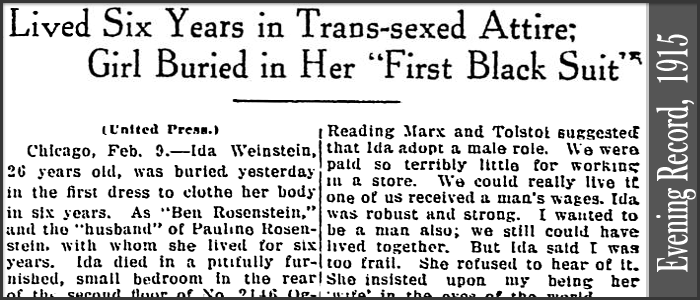
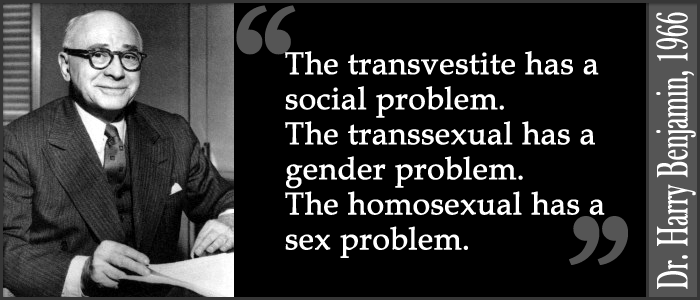
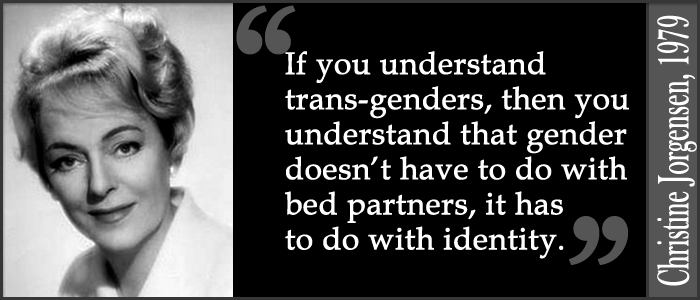
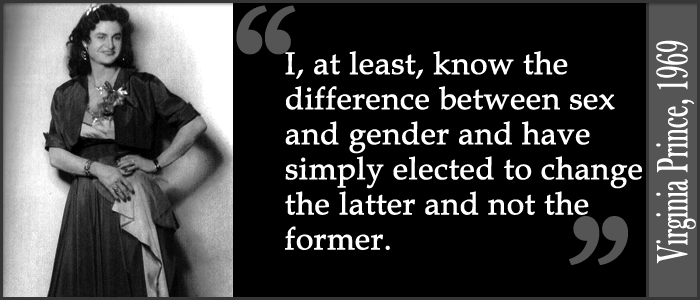
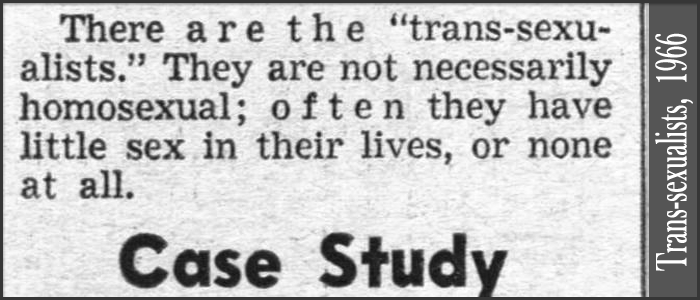
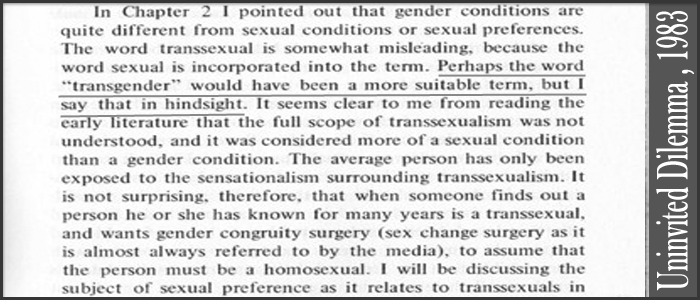
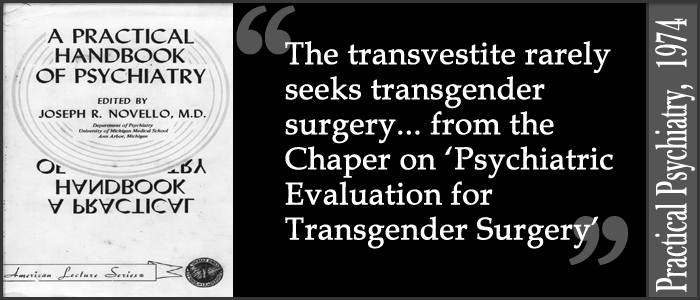
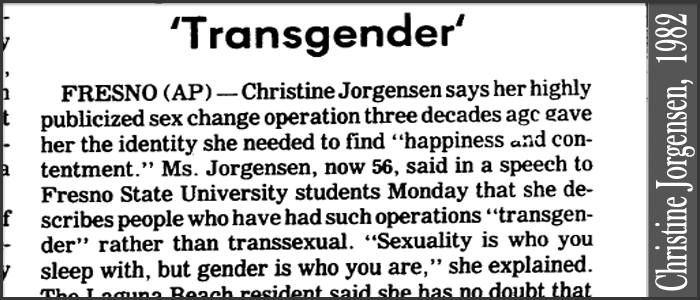
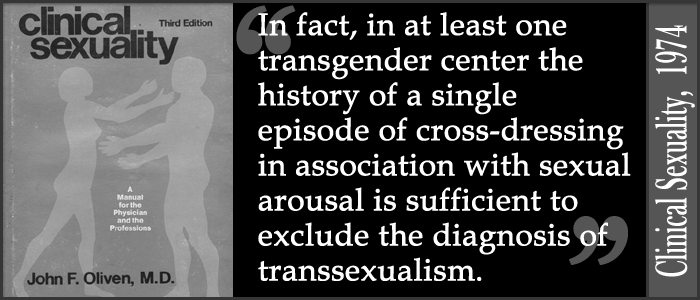

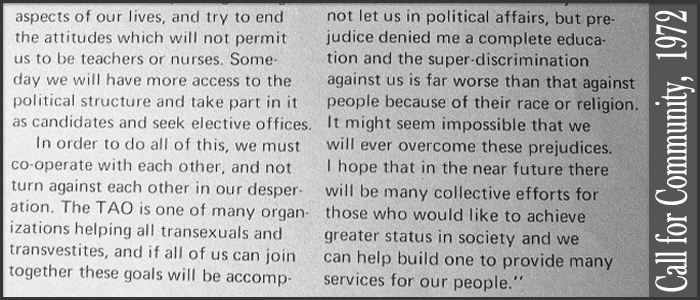
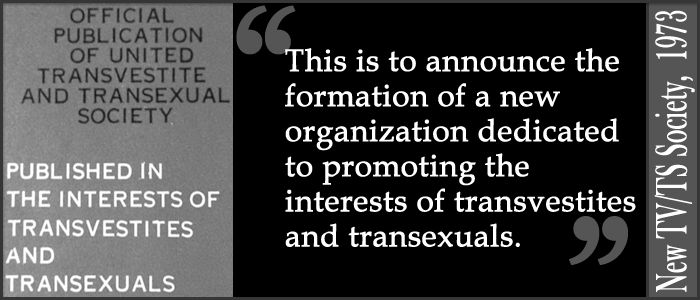
Tracking Transgender: The Historical Truth http://t.co/Pug8GBgJ via @cristanwilliams
Tracking Transgender: The Historical Truth http://t.co/5qZSCAlK via @zite
Tracking Transgender: The Historical Truth | Ehipassiko http://t.co/lwBluRke